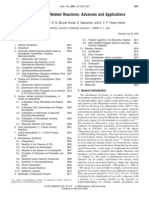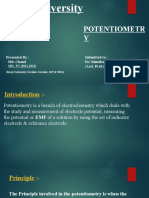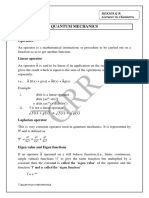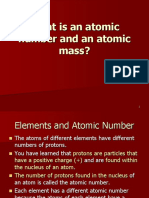2D NMR Printerfriendly
2D NMR Printerfriendly
Uploaded by
Sundararaju BaskerCopyright:
Available Formats
2D NMR Printerfriendly
2D NMR Printerfriendly
Uploaded by
Sundararaju BaskerCopyright
Available Formats
Share this document
Did you find this document useful?
Is this content inappropriate?
Copyright:
Available Formats
2D NMR Printerfriendly
2D NMR Printerfriendly
Uploaded by
Sundararaju BaskerCopyright:
Available Formats
Multidimensional NMR
Experiments
Chem 8361/4361:
Interpretation of Organic Spectra
20092013 Andrew Harned & Regents of the University of Minnesota
2D NMR Spectroscopy
General Information
More complicated experiments to set up than
1
H and
13
C
Changes in pulses (#, length, angles, mixing times, etc.)
Observe effects based on relationship of nuclei
**Can be homonuclear (same nuclei) (e.g. HH) or heteronuclear
(different nuclei) (e.g. HC, HP, etc.)**
Will only go over the what the experiments tell you and how
to interpret, and only for the most common and widely used
for solving organic structures
DEPT, HH COSY, HMQC (HETCOR), HMBC,
INADEQUATE (CC COSY)
There is a whole alphabet soup of other experiments (both 1D
and 2D)
EXSY, TOCSY, HOHAHA, INEPT, WATERGATE, and many more
http://www.chem.ox.ac.uk/spectroscopy/nmr/acropage.htm
2D NMR Spectroscopy
Number of Protons on Carbon
DEPT (Distortionless Enhancement by Polarisation Transfer
Used to be known as APT (Attached Proton Test)
DEPT is
1
H-detected; APT is
13
C-detected
Tells you how many protons are attached to a particular carbon
negative peaks = CH
2
positive peaks = CH and CH
3
(distinguishable with further
processing)
missing peaks = carbons w/o protons
With a little help from IR and chemical shift of
1
H and
13
C, can get a
rough idea of molecular weight
2D NMR Spectroscopy
Number of Protons on Carbon
DEPT (Distortionless Enhancement by Polarisation Transfer
1
1 = Carbon spectrum
2
2 = ! CH
2
" CH, CH
3
3
3
= " CH
135
pulse
90
pulse
Tells you which protons are coupled to one another
Very useful when peaks are overlapping in
1
H NMR and you are
unable to calculate coupling constants, or when there are a lot of
similar coupling constants
Cross peaks are coupled
to each other
Newer method is DQF (Double Quantum Filtered)-COSY
same information, but looks cleaner
2D NMR Spectroscopy
Who is Talking to Who?
1
H
1
H COSY (Correlation Spectroscopy)
C C C
H
1 bond HH coupling
H
2D NMR Spectroscopy
Who is Talking to Who?
1
H
1
H COSY (Correlation Spectroscopy)
1H
1H
4H
2H 2H 1H
3H
3H
2H
Overlapping protons and a lot of similar coupling constants
Rafnosea trisaccharide
2D NMR Spectroscopy
Who is Talking to Who?
1
H
1
H COSY (Correlation Spectroscopy)
Rafnosea trisaccharide
2D NMR Spectroscopy
Who is Talking to Who?
1
H
1
H COSY (Correlation Spectroscopy)
4H
1H
1H
2H
2H
1H
3H
3H
2H
2D NMR Spectroscopy
Who is Talking to Who?
1
H
1
H COSY (Correlation Spectroscopy)
DQF-COSY: Double Quantum Filtered COSY cleans up the
spectrum by reducing noncoupled systems (e.g. CH3 singlets)
CH
2
CH
2
H
3
C CH
3
HO
Ipsenol
2D NMR Spectroscopy
Who is Talking to Who?
1
H
1
H COSY (Correlation Spectroscopy)
DQF-COSY: Double Quantum Filtered COSY cleans up the
spectrum by reducing noncoupled systems (e.g. CH3 singlets)
CH
2
CH
2
H
3
C CH
3
HO
Ipsenol
2D NMR Spectroscopy
Who is Talking to Who?
1
H
1
H COSY (Correlation Spectroscopy)
C
6
H
10
O
2
2D NMR Spectroscopy
Who is Talking to Who?
1
H
1
H COSY (Correlation Spectroscopy)
O
O
Tells you which protons are coupled to one another
Very useful when peaks are overlapping in
1
H NMR and you are
unable to calculate coupling constants, or when there are a lot of
similar coupling constants
Cross peaks are coupled
to each other
Recall...
1
H
1
H
COSY
C C C
H
H
2 & 3 bond HH coupling
H
Tells you which protons are coupled to one another
Very useful when peaks are overlapping in
1
H NMR and you are
unable to calculate coupling constants, or when there are a lot of
similar coupling constants
Cross peaks are coupled
to each other
Recall...
1
H
1
H
COSY
C C C
H
H
2 & 3 bond HH coupling
H
4H
1H
1H
2H
2H
1H
3H
3H
2H
This can still cause
ambiguities!
2D NMR Spectroscopy
Who is Talking to Who?
1
H
1
H TOCSY (Total Correlation Spectroscopy)
Tells you which protons are in the same spin system (a continuous chain
of spin-spin coupled protons)
Magnetization from H
A
is transferred to H
B
, which then transfers to H
C
and on down the line
Can be run as either a 1D or 2D experiment
Running as a 1D experiment greatly simplies spectra with severe signal
overlap
Related experiment (HOHAHA) gives essentially the same information
Can also observe one-bond
1
H
13
C couplings (HMQC-TOCSY,
hetero-TOCSY, HEHAHA) - will not discuss
C C C
H
A
H
B
C C
H
C
H
D
H
E
1D TOCSY
Spin System Identication
1
H
1
H TOCSY (Total Correlation Spectroscopy)
Irradiate at frequency of proton of interest
Wait a period of time (typically 20 to 400 ms) and then collect
1D spectrum
Only observe protons to which magnetization has been transferred
Short periods of time (20 ms) will only give rise to single step
transfers; longer periods of time allow magnetization to propagate
further
!- and "-lactose
1D TOCSY
Spin System Identication
O
H
4
O
H
3
HO
H
2
H
1
OH
H
5
OH
OH
O
HO
H
H
HO
H
H
OH
H
OH
!-lactose
4.67 ppm
H
6
,H
6'
1D TOCSY
Claridge, T. D. W. High-Resolution NMR Techniques in Organic Chemistry, 2nd Ed., Elsevier, 2009.
O
H
N
O O
H
N
O
O
N
3
O O
O
O
O
O O
O
2
A B,C D
1
2
3 4
5
6
1D TOCSY
Claridge, T. D. W. High-Resolution NMR Techniques in Organic Chemistry, 2nd Ed., Elsevier, 2009.
O
HN
O
O
HN
O
O
N
3
O
O
O
O
O
O
O
O
2
A
B,C
D
1
2
3
4
5
6
2D TOCSY
Spin System Identication
1
H
1
H TOCSY (Total Correlation Spectroscopy)
Cross peaks are in the same spin system
O
OH HO
N
3
O
O
1
2
3 4
5
6
COSY TOCSY
Claridge, T. D. W. High-Resolution NMR Techniques in Organic Chemistry, 2nd Ed., Elsevier, 2009.
N
N
2
3
4
5
6
7
8
9 10
11
12
13
17
19
29
25
23
2D TOCSY
Cross peaks are in the same spin system
Claridge, T. D. W. High-Resolution NMR Techniques in Organic Chemistry, 2nd Ed., Elsevier, 2009.
Intermediate in biomimetic
synthesis of manzamine
N
N
2
3
4
5
6
7
8
9 10
11
12
13
17
19
29
25
23
2D TOCSY
Cross peaks are in the same spin system
Claridge, T. D. W. High-Resolution NMR Techniques in Organic Chemistry, 2nd Ed., Elsevier, 2009.
Intermediate in biomimetic
synthesis of manzamine
N
N
2
3
4
5
6
7
8
9 10
11
12
13
17
19
29
25
23
2D TOCSY
Cross peaks are in the same spin system
Claridge, T. D. W. High-Resolution NMR Techniques in Organic Chemistry, 2nd Ed., Elsevier, 2009.
Intermediate in biomimetic
synthesis of manzamine
New Developments
Deconvolution via MDEC
MDEC (Multi Frequency Homonuclear Decoupling)
Conceptually the same as the homonuclear decoupling experiment
mentioned earlier, but allows multiple frequencies to be decoupled
at the same time
J. Am. Chem. Soc. 2009, 131,
1599415995
(a)
1
H NMR
(b) irr @ H-1
(c) irr @ H-1/H-7
(d) irr @ H-1/H-3a/H-7
H-2 (dddd)
H-2 (app dt)
H-2 (dd, J = 3.3, 12.2 Hz)
H
2
H
Me
H
1
OH
H
3b
H
3a
Me
Me
H
7
1
2
3
7
OH
X
X
X
New Developments
Deconvolution via MDEC
1D-TOCSY-MDEC
J. Am. Chem. Soc. 2009, 131, 1599415995
1
2
3
4
O
O
Me
H
H
H
Me
Me
H
6
(a)
1
H NMR
(b) 1D-TOCSY
irr @ H-3
(c) 1D-TOCSY
irr @ H-3 with
MDEC @ H-1b,
H-2b, H-3
H-2a
X
X
X
2D NMR Spectroscopy
Who is Talking to Who?
1
H
13
C COSY
HETCOR (Heteronuclear Correlation)
older experiment;
13
C-detected
HMQC (Heteronuclear Multiple Quantum Correlation) and
HSQC (Heteronuclear Single Quantum Correlation)
newer experiments;
1
H-detected; largely replaced HETCOR
Both give same information, experimentally very different
Peaks have one-bond coupling (i.e. attached directly)
Compliments DEPT
Particularly useful for diastereotopic protons
C C C
H
1 bond HC coupling
2D NMR Spectroscopy
Who is Talking to Who?
HMQC
C C C
H
1 bond HC coupling
2D NMR Spectroscopy
Who is Talking to Who?
HMQC
C C C
H
1 bond HC coupling
Diastereotopic
Protons
2D NMR Spectroscopy
Who is Talking to Who?
HMQC
Can see into
multiplets
H
2
C
O
CH
3
H
H
H
3
C
H
3
C
Caryophyllene Oxide
2D NMR Spectroscopy
Who is Talking to Who?
HMQC
O
O
2D NMR Spectroscopy
HO
Cl
2D NMR Spectroscopy
HO
Cl
2D NMR Spectroscopy
HO
Cl
2D NMR Spectroscopy
Who is Talking to Who?
1
H
13
C COSY (Long Range)
COLOC (Correlated spectroscopy for Long range Couplings)
older experiment;
13
C-detected
HMBC (Heteronuclear Multiple Bond Coherence)
newer experiment;
1
H-detected; completely replaced COLOC
Both give same information, experimentally very different
Peaks have two- or three-bond coupling
Sees through heteroatoms and quaternary carbons
Can be very complicated, but is very powerful
C C C
H
2 and 3 bond HC couplings
H
1
2 3
C O C
H
H
1
2 3
C C C
H
H
O
1
2 3
2D NMR Spectroscopy
Who is Talking to Who?
HMQC
C C C
H
1 bond HC coupling
2D NMR Spectroscopy
Who is Talking to Who?
HMBC
C C C
H
2 and 3 bond HC couplings
H
1
2 3
2D NMR Spectroscopy
Who is Talking to Who?
OCH
3
OH
OH
OCH
3
or
2D NMR Spectroscopy
Who is Talking to Who?
OCH
3
OH
OH
OCH
3
or
2D NMR Spectroscopy
Who is Talking to Who?
OCH
3
OH
OH
OCH
3
or
2D NMR Spectroscopy
Who is Talking to Who?
OCH
3
OH
OH
OCH
3
or
2D NMR Spectroscopy
Who is Talking to Who?
OCH
3
OH
OH
OCH
3
or
2D NMR Spectroscopy
Who is Talking to Who?
13
C
13
C COSY
INADEQUATE (Incredible Natural Abundance Double Quantum
Transfer Experiment)
tells what carbons are attached to each other
if you know what type of carbon it is (C, C=O, CH, CH
2
, CH
3
, etc.)
from DEPT, you can almost write down the entire gross structure by
running two NMR experiments
BUT it is
13
C
13
C coupling
probability of one
13
C is 0.01
two next to each other 0.01x0.01 = 0.0001
(~1 molecule in 10,000)
Need lots of sample and instrument time to overcome
In our facility: 80% v/v, overnight, 500 MHz = nothing
C C C
1 bond CC coupling
O
N
2D NMR Spectroscopy
Who is Talking to Who?
INADEQUATE
C C C
1 bond CC coupling
2D NMR Spectroscopy
Who is Talking to Who?
INADEQUATE
Cross peaks show up as doublets = J
CC
Diagonal is midway between the two doublets
5 4 1 9 103 11 2 15 12
6,7
14
2D NMR Spectroscopy
OH
CH C CH CH2 C CH2
CH3,CH3,CH2,CH3
2D NMR Spectroscopy
2D NMR Spectroscopy
C C,CH
2D NMR Spectroscopy
C C CH CH CH2 CH2 CH3 CH3 x2
O
Br
Which
Isomer?
2D NMR Spectroscopy
O
Br
2D NMR Spectroscopy
O
Br
You might also like
- Statement of Research Interests-ExampleDocument3 pagesStatement of Research Interests-ExampleNedelcuGeorge100% (1)
- 303 - 11 Final Exam KEY-1 PDFDocument22 pages303 - 11 Final Exam KEY-1 PDFaegaisNo ratings yet
- Ws10 AnswersDocument4 pagesWs10 AnswersKassimNo ratings yet
- Design, Molecular Docking Studies, in Silico Drug Likeliness Prediction and Synthesis of Some Benzimidazole Derivatives As Antihypertensive AgentsDocument11 pagesDesign, Molecular Docking Studies, in Silico Drug Likeliness Prediction and Synthesis of Some Benzimidazole Derivatives As Antihypertensive AgentsBaru Chandrasekhar RaoNo ratings yet
- Neighbouring Group Participation or NGP inDocument4 pagesNeighbouring Group Participation or NGP inbharatbhushansankhya100% (1)
- 2D NMR PDFDocument50 pages2D NMR PDFm__rubelNo ratings yet
- High Performance Thin Layer Chromatography HPTLC BY Simran Singh Rathore M Pharm Pqa (Mpat)Document38 pagesHigh Performance Thin Layer Chromatography HPTLC BY Simran Singh Rathore M Pharm Pqa (Mpat)Simran Singh RathoreNo ratings yet
- Hyperchem QSAR 2Document37 pagesHyperchem QSAR 2rafida aisyahNo ratings yet
- PC11 Molecular Electronic StructureDocument72 pagesPC11 Molecular Electronic StructureAnand MishraNo ratings yet
- Gaussian & Gaussview: Shubin Liu, Ph.D. Research Computing Center, Its University of North Carolina at Chapel HillDocument86 pagesGaussian & Gaussview: Shubin Liu, Ph.D. Research Computing Center, Its University of North Carolina at Chapel HillRAMKUMARNo ratings yet
- Linear Combination of Atomic OrbitalsDocument11 pagesLinear Combination of Atomic OrbitalsAnonymous gUjimJKNo ratings yet
- Semi-Empirical MethodsDocument3 pagesSemi-Empirical MethodsludihemicarNo ratings yet
- Linear Combination of Atomic Orbitals (LCAO) in Homonuclear Diatomic MoleculesDocument2 pagesLinear Combination of Atomic Orbitals (LCAO) in Homonuclear Diatomic MoleculesSuman DasNo ratings yet
- Mitsunobu and Related Reactions - Advances and ApplicationsDocument101 pagesMitsunobu and Related Reactions - Advances and ApplicationsSuresh BabuNo ratings yet
- Guide To Solving Spectroscopy ProblemsDocument4 pagesGuide To Solving Spectroscopy ProblemsJen100% (1)
- SCH 402 Nomenclature of Fused Heterocycles PDFDocument17 pagesSCH 402 Nomenclature of Fused Heterocycles PDFSabz PariNo ratings yet
- 1HNMR Lecture NotesDocument53 pages1HNMR Lecture NotesJian Hong Tee100% (1)
- Tutorial 3 (Mass Spectrometry & Infra-Red Spectroscopy)Document6 pagesTutorial 3 (Mass Spectrometry & Infra-Red Spectroscopy)Ahmed ZakyNo ratings yet
- MSC Exam Spectroscopy 2018 FINALDocument2 pagesMSC Exam Spectroscopy 2018 FINALPaige MunroeNo ratings yet
- Electron Transfer in BiologyDocument20 pagesElectron Transfer in BiologyVani KaushikNo ratings yet
- كيمياء تحليلية A+2024Document29 pagesكيمياء تحليلية A+2024zloa616No ratings yet
- Methods of Estimation of MultiDocument41 pagesMethods of Estimation of Multiapi-19786321100% (1)
- Chand Potentiometry PresentationDocument29 pagesChand Potentiometry PresentationMd ChandNo ratings yet
- - - كيمياء تحليلية -تسحيح - vhDocument18 pages - - كيمياء تحليلية -تسحيح - vhyr44grf94kNo ratings yet
- Pka Determination Using SpectrometryDocument7 pagesPka Determination Using SpectrometryVanitha SelvarajanNo ratings yet
- Answer KeyDocument6 pagesAnswer KeyMadhavanIceNo ratings yet
- Classification of LigandsDocument9 pagesClassification of LigandsNorbert TongeraiNo ratings yet
- Difference Reverse Phase and Normal PhaseDocument8 pagesDifference Reverse Phase and Normal PhaseValeriaCusumanoNo ratings yet
- MSC Chemistry Paper-IX Unit-5Document56 pagesMSC Chemistry Paper-IX Unit-5Alexa Torres100% (1)
- Neighbouring Group ParticipationDocument15 pagesNeighbouring Group ParticipationAbdulMananNo ratings yet
- HDA Flow ChartDocument9 pagesHDA Flow ChartPrince GuptaNo ratings yet
- Conductometric Titrations: Submitted ToDocument10 pagesConductometric Titrations: Submitted ToFaraz AnjumNo ratings yet
- Woodward-Hoffmann RulesDocument2 pagesWoodward-Hoffmann Rulesjyothirlatha venkata nageswariNo ratings yet
- When We Applied Back TitrationDocument3 pagesWhen We Applied Back TitrationHanaa Abo SweirhNo ratings yet
- Quantum Mechanics (Remaining)Document7 pagesQuantum Mechanics (Remaining)vandv printsNo ratings yet
- Instrumental Chemical AnalysisDocument39 pagesInstrumental Chemical AnalysisparthabakalNo ratings yet
- Exercise Z Matrix CH4Document18 pagesExercise Z Matrix CH4Manjeet BhatiaNo ratings yet
- Nuclear Magnetic Resonance: Half-Integer Odd Odd or EvenDocument19 pagesNuclear Magnetic Resonance: Half-Integer Odd Odd or EvenRAJ VYASNo ratings yet
- Lectures in Heterocyclic ChemistryDocument130 pagesLectures in Heterocyclic ChemistrySebastián Salazar100% (1)
- UV-visible Spectrum of A Transition Metal Complex (d3 - d8) From Internet - Assign The Peaks and Using The Appropriate Tanabe - Sugano Diagram Calculate Do For The Complex.Document5 pagesUV-visible Spectrum of A Transition Metal Complex (d3 - d8) From Internet - Assign The Peaks and Using The Appropriate Tanabe - Sugano Diagram Calculate Do For The Complex.peptidesynthesizerNo ratings yet
- 3 Rotational Spectroscopy1Document19 pages3 Rotational Spectroscopy1Omprakash LatiyalNo ratings yet
- Challenge Problems in David Klein Chap 7-17Document32 pagesChallenge Problems in David Klein Chap 7-17Ling LingNo ratings yet
- Optical-Methods Part1Document7 pagesOptical-Methods Part1Sumedha Thakur0% (1)
- Huckel Theory For Conjugated Systems: CH 105: Organic ChemistryDocument72 pagesHuckel Theory For Conjugated Systems: CH 105: Organic ChemistryRaunaq Bhirangi100% (1)
- Experiment 10Document6 pagesExperiment 10Roman100% (2)
- Nuclear Overhauser Effect (NOE)Document5 pagesNuclear Overhauser Effect (NOE)Salustiano JurandiNo ratings yet
- CHE 276 PPT - Introduction To Organic SpectrosDocument8 pagesCHE 276 PPT - Introduction To Organic SpectrosEmmy OlabosipoNo ratings yet
- Problem Set 13 and 14Document6 pagesProblem Set 13 and 14sophia del rosario100% (1)
- Introduction To Chromatography PPTDocument11 pagesIntroduction To Chromatography PPTManjesh K NagwanshiNo ratings yet
- Retrosynthetic AnalysisDocument13 pagesRetrosynthetic AnalysismelprvnNo ratings yet
- PDF Corrected Surface ChemistryDocument51 pagesPDF Corrected Surface ChemistryRSLNo ratings yet
- Physical Chemistry (CHM3101) : Equilibrium Electrochemistry Reference: Atkins, 9 Edition, Chapter 6Document43 pagesPhysical Chemistry (CHM3101) : Equilibrium Electrochemistry Reference: Atkins, 9 Edition, Chapter 6Nur EizzatiNo ratings yet
- Inorganic Chemistry: Chemical BondingDocument41 pagesInorganic Chemistry: Chemical BondingAshok MukhijaNo ratings yet
- UNIT 8.d&f-BLOCK ELEMENTSDocument14 pagesUNIT 8.d&f-BLOCK ELEMENTS16739No ratings yet
- Friedel Crafts ReactionsDocument6 pagesFriedel Crafts ReactionsjanmanchiNo ratings yet
- GaussianDocument6 pagesGaussiannootsam100% (1)
- 2DNMRDocument37 pages2DNMRprasad0625No ratings yet
- NMR Class Lecture 15Document44 pagesNMR Class Lecture 15VNo ratings yet
- Chapter 4. Nuclear Magnetic Resonance Spectroscopy: I. H NMRDocument34 pagesChapter 4. Nuclear Magnetic Resonance Spectroscopy: I. H NMRSobia NoreenNo ratings yet
- 2d NMRDocument32 pages2d NMRDelicz TanNo ratings yet
- How Do Electrons and Holes Populate The Bands?: Probability of Occupation (Fermi Function) ConceptDocument4 pagesHow Do Electrons and Holes Populate The Bands?: Probability of Occupation (Fermi Function) ConceptmustafaphyNo ratings yet
- Atomic Structure - Study NotesDocument16 pagesAtomic Structure - Study NotesTamoghna DeyNo ratings yet
- Orbiting The Moons of Pluto PDFDocument412 pagesOrbiting The Moons of Pluto PDFsterling goin100% (2)
- N The Ogoliubov DE Ennes Equations: A. J. LeggettDocument14 pagesN The Ogoliubov DE Ennes Equations: A. J. LeggettHercules De Souza SantanaNo ratings yet
- Nuclear Physics BDocument537 pagesNuclear Physics Bbuddy72No ratings yet
- Op To ElectronicsDocument745 pagesOp To ElectronicsLiza SammyNo ratings yet
- 2nd FileDocument38 pages2nd FileCollege of Computer Sciences BasirpurNo ratings yet
- Edwin VargasDocument20 pagesEdwin VargasMaximilian Renato Farfan PastranaNo ratings yet
- Thesis ReportDocument15 pagesThesis ReportTabish ShibliNo ratings yet
- HeisenbergDocument16 pagesHeisenbergkethavarapuramjiNo ratings yet
- 66 - 15575 - EC210 - 2014 - 1 - 2 - 1 - Lecture 11Document10 pages66 - 15575 - EC210 - 2014 - 1 - 2 - 1 - Lecture 11Mohamed MamdouhNo ratings yet
- History and Models of The Atom: Click On MeDocument26 pagesHistory and Models of The Atom: Click On MeRon Adrian Sarte SebastianNo ratings yet
- ITPO 2016 ProblemsDocument2 pagesITPO 2016 Problemsfreefall014100% (1)
- Worksheet - Orbital Diagrams - TeacherDocument2 pagesWorksheet - Orbital Diagrams - Teacherdela2100% (3)
- PACS AllDocument152 pagesPACS AllistefanmarianNo ratings yet
- 3.091 - Introduction To Solid State Chemistry Lecture Notes No. 1 Atomic and Electronic StructureDocument21 pages3.091 - Introduction To Solid State Chemistry Lecture Notes No. 1 Atomic and Electronic Structuremukul kumarNo ratings yet
- Eng Phy - Ii Unit-1 PDFDocument19 pagesEng Phy - Ii Unit-1 PDFpuceiroaleNo ratings yet
- The Standard ModelDocument95 pagesThe Standard ModelaliakouNo ratings yet
- Atomic Mass and NumberDocument15 pagesAtomic Mass and NumberKalaisan KalaichelvanNo ratings yet
- Electromagnetically Induced Transparency in Mechanical Effects of LightDocument4 pagesElectromagnetically Induced Transparency in Mechanical Effects of LightMottu SinghNo ratings yet
- Conservation of EnergyDocument3 pagesConservation of EnergyessaidNo ratings yet
- HW 12Document4 pagesHW 12Rak KhanNo ratings yet
- JINR GodovoyOtchet 22 EngDocument183 pagesJINR GodovoyOtchet 22 EngAlex Ioan OpreaNo ratings yet
- Condensed Matter PhysicsDocument1 pageCondensed Matter PhysicsAmritKumarNo ratings yet
- Ehrenfest's Theorem PDFDocument37 pagesEhrenfest's Theorem PDFSami HaidarNo ratings yet
- Rks@cuh - Ac.in: Unit-2 (Symmetry in Quantum Mechanics)Document13 pagesRks@cuh - Ac.in: Unit-2 (Symmetry in Quantum Mechanics)AviteshNo ratings yet
- Synchro CyclotronDocument5 pagesSynchro CyclotronSäjidëë KisÅnNo ratings yet
- Energy Levels: 4.1 Bound ProblemsDocument23 pagesEnergy Levels: 4.1 Bound ProblemsLoubnanNo ratings yet
- Modern Physics Practice FinalDocument6 pagesModern Physics Practice FinalCurt FreeNo ratings yet

























































































